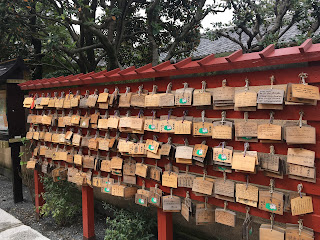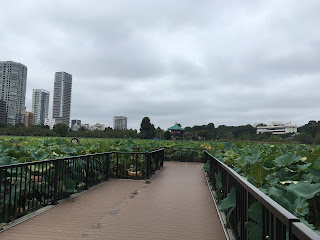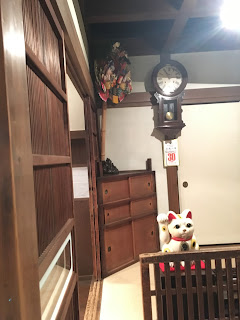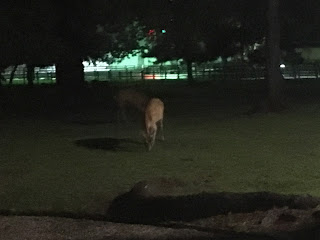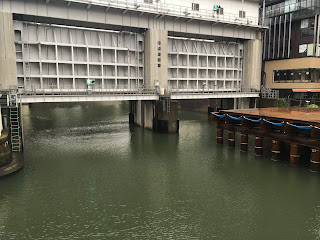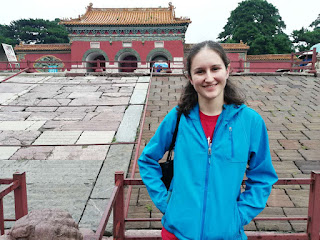1. The swastikas on Apple Maps have nothing to do with the Nazis or WWII
I actually knew this one in advance, but it's worth mentioning. If you use Apple Maps as much as I do, you'll see these swastika symbols all over the maps.
The WWII buffs out there will recognize that symbol as the symbol of the Nazi party in Germany in WWII - Hitler's party. So it isn't much of a leap to conclude that those symbols are some kind of WWII memorial or something. The fact that Japan was on the same side as Nazi Germany would only make that even more of a logical conclusion.
But the thing is, in Japan, that symbol has nothing to do with Hitler or Nazism. Long before Hitler saw it, the swastika was a symbol of good fortune in India and Hindu traditions. Hinduism is the predecessor to Buddhism, and Buddhism is a very popular religion in Japan (this article says at the end that 90 million Japanese consider themselves Buddhist). So basically, when you see a swastika on Apple Maps, it's not a Nazi memorial or something else. It's a Buddhist temple.
2. You really do need to take off your shoes when you go into Japanese buildings
This isn't true about restaurants or train stations, but otherwise, we took our shoes off for every single building we went into. That includes museums and the hostels we stayed in. I think a part of it is that some places still have those soft cloth floors you see in pictures, but another part of it must be cultural.
Interestingly, the first hostel we stayed at had a separate pair of slippers to use in the bathroom. You weren't supposed to wear normal slippers into the bathroom. There was a sign explaining that this was to help keep their floors pure, and I'm not sure if that was culturally pure or just ordinarily clean.
Speaking of which...
3. Japan is extremely clean
At least, the parts we saw were. The train stations had no litter, I never saw graffiti, and they actually have special wipes just to clean the toilet seat after you use it. It's that clean.
4. People speak English
You know the myth that "everywhere you go, people speak English"? That's not true about a lot of places, but in Tokyo, Kyoto, and Nara, that seemed to be true. I'm accustomed to Shenyang, where nobody speaks much English and I'm getting around by pointing. That means that something like this happened more than once:
Me: *pointing to a picture* "This, please."
Store clerk: "You want beef with ramen noddles? Would you like salad, soup, or dessert with that? And what to drink?"
5. The actual places in Tokyo may not have a lot of information about them
My first day in Tokyo, when I was wandering around Ueno, I stopped at a lot of shrines. Some of them were in a guide book, and some not, but I made a point of finding ones in my guide book. The guide book didn't say much about them, though, so I figured I could just read the signs when I got there.
And... there were no signs when I got there.
Seriously, I think even the Meiji Shrine and the Sensoji Temple were missing those tour guide signs (although I'm not sure about Sensoji). I would highly recommend researching the places you want to go before you go there, so you have information about them.
The exception to this was the Imperial Palace. There was a guided tour app you could download to hear information in English. I actually used the app to help me write the blog posts.
Having said all this, let me mention two caveats. The first is that all of this was in Tokyo, and not in Kyoto. I only spent half a day in Kyoto, and I only saw one place, so I don't know about the rest of Kyoto.
The second is that I never did any tours. Tours really are a good thing to invest in, because the people who lead them will have lots of extra information. Just make sure to book your tours far enough in advance.
6. They really are extremely polite
They say a picture's worth a thousand words, so...
It says, "Please set your mobile phone on 'manner mode' and refrain from speaking on the phone". Silent mode is apparently called "manner mode" in Japan.
And people actually do bow when they meet each other in Japan.
And people actually do bow when they meet each other in Japan.
7. It's a highly functional, accommodating, and all-around nice place to be!
It's definitely traveler-friendly, if all the previous information wasn't enough. To give you more of an idea:
- When you land at Kansai International Airport in Osaka, they have people greeting you off the plane with little fingernail clippers. When you depart Kansai, they have people giving you kleenex packets. Little niceties like that.
- Hostels - not hotels, hostels - provided us with a temporary cell phone (I think it was called a Handy).
- There are multiple efficient, cheap, and accommodating ways to travel between cities and the airports. Similar to Iceland (always a favorable comparison coming from me), you can buy transportation on the plane.
- Pretty much all the transportation information is in multiple languages.
- They have mountains. And they are beautiful!
- You don't need a visa to get into Japan (unlike China).
The places I was in - Nara, Tokyo, and Kyoto - were full of pleasant people, pleasant places, and low-hassle experiences. Travel was easy, food was good, and people were helpful.
Keep in mind that we weren't staying in any luxury places. We were staying in budget places. I can only imagine how awesome Japan's luxury places are (and, my friends, they have many).
If you want to travel somewhere that has all the comforts of modernity, but also a very distinct modern culture, I highly recommend Japan. It's just a fabulous place!











